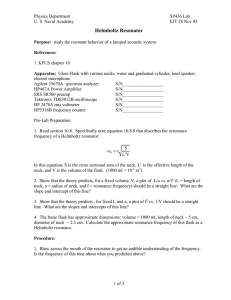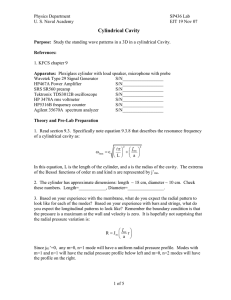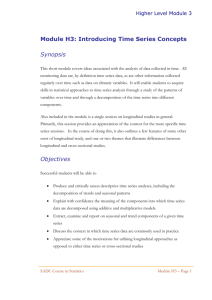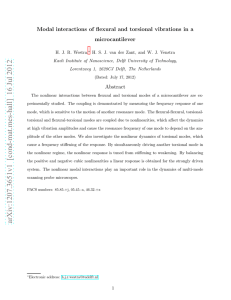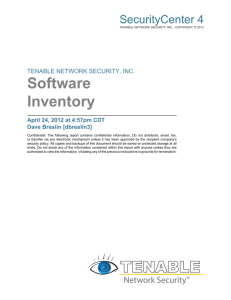Waves in Bars
advertisement
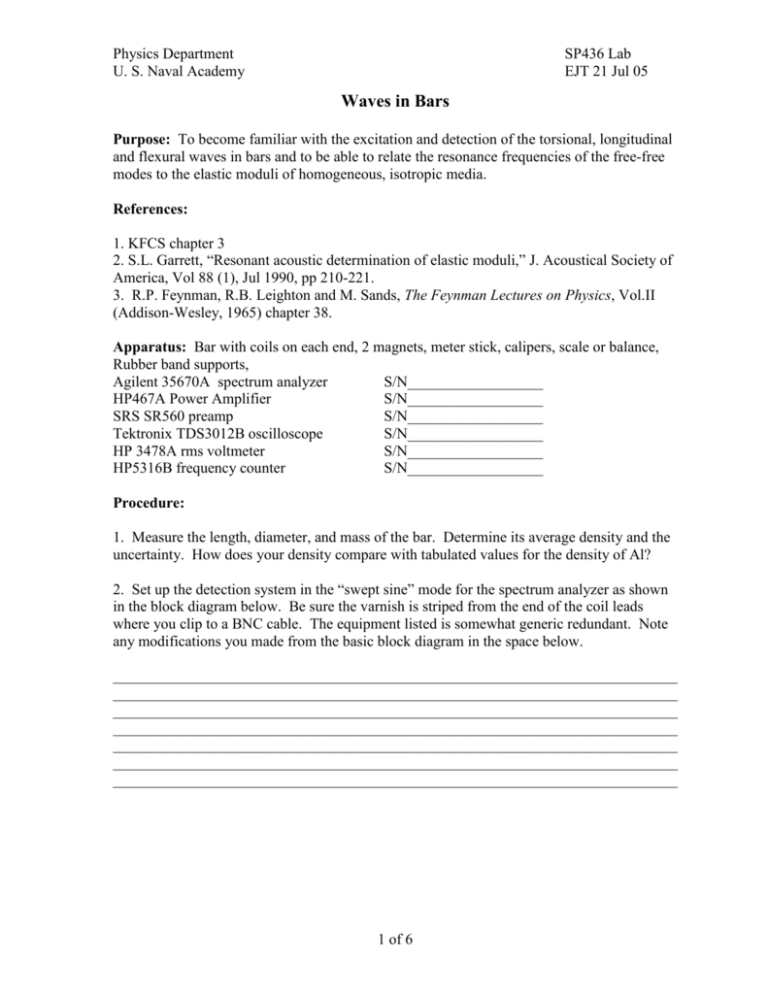
Physics Department U. S. Naval Academy SP436 Lab EJT 21 Jul 05 Waves in Bars Purpose: To become familiar with the excitation and detection of the torsional, longitudinal and flexural waves in bars and to be able to relate the resonance frequencies of the free-free modes to the elastic moduli of homogeneous, isotropic media. References: 1. KFCS chapter 3 2. S.L. Garrett, “Resonant acoustic determination of elastic moduli,” J. Acoustical Society of America, Vol 88 (1), Jul 1990, pp 210-221. 3. R.P. Feynman, R.B. Leighton and M. Sands, The Feynman Lectures on Physics, Vol.II (Addison-Wesley, 1965) chapter 38. Apparatus: Bar with coils on each end, 2 magnets, meter stick, calipers, scale or balance, Rubber band supports, Agilent 35670A spectrum analyzer S/N__________________ HP467A Power Amplifier S/N__________________ SRS SR560 preamp S/N__________________ Tektronix TDS3012B oscilloscope S/N__________________ HP 3478A rms voltmeter S/N__________________ HP5316B frequency counter S/N__________________ Procedure: 1. Measure the length, diameter, and mass of the bar. Determine its average density and the uncertainty. How does your density compare with tabulated values for the density of Al? 2. Set up the detection system in the “swept sine” mode for the spectrum analyzer as shown in the block diagram below. Be sure the varnish is striped from the end of the coil leads where you clip to a BNC cable. The equipment listed is somewhat generic redundant. Note any modifications you made from the basic block diagram in the space below. ___________________________________________________________________________ ___________________________________________________________________________ ___________________________________________________________________________ ___________________________________________________________________________ ___________________________________________________________________________ ___________________________________________________________________________ ___________________________________________________________________________ 1 of 6 Physics Department U. S. Naval Academy SP436 Lab EJT 21 Jul 05 Spectrum analyzer source Power amplifier pickup coil Ch 1 drive coil Ch 2 Bar under test rms voltmeter Ch 1 O-scope freq counter Ch 2 Pre amp Figure 1. Block diagram for swept sine mode resonance analysis of a bar. 3. Torsional mode. Position the magnets a couple of centimeters from the ends of the bar and rotate the bar so the plane of the coils is horizontal as shown in figure 2 below. In this configuration, a current in the drive coil causes the wires to exert a torsional force about the longitudinal axis of the bar. This torsional oscillation of the bar will induce an emf in the pickup coil. The frequency of the G nc f nT T 2L 2L n KFCS 3.4.3. and 3.13.6 4. Spectrum Analyzer Setup. Instrument Mode: Swept Sign Source Level: 1 v rms Linear Sweep Manual Frequency: Start 1kHz Stop 7kHz Resolution Setup: Resolution: at least 500 points/sweep Trace Coordinate: Linear Amplitude (you will select others later) Scale: Auto scale “on” 2 of 6 Physics Department U. S. Naval Academy SP436 Lab EJT 21 Jul 05 2 5. Power and Pre Amp Setup. Power Amp – 2x amplification (this sould provide 2 vrms to the drive coils as seen on the multimeter and oscilloscope. Pre Amp – Band pass filter 300 – 10000 Hz (adjust as needed) AC coupling Gain: ~20 6. Data Collection and Recording. Press start on the frequency analyzer to begin sweeping through the frequencies. While data is being gathered, you will see the frequency increase on the analyzer and frequency counter. A trace will be drawn on the display. When complete press: “Save/Recall” “Save Data” Format -> “ASCII” “Save Trace” “To File” name the file using the letters on the keyboard and finally, “enter” to save to an external floppy. 7. Flexural Modes. Rotate the bar by 90 degrees on the rubber band stand and place the pole pieces as shown in figure 3 below. The gradient in the magnetic field will produce an unbalanced oscillating vertical force that will excite the transverse bending or flexural modes. These frequencies will be much lower than the torsional modes. Predict the resonance frequencies from the below equation and adjust the sweep frequency and band pass filter to include the first 5 or so resonances. 3 of 6 Physics Department U. S. Naval Academy SP436 Lab EJT 21 Jul 05 f nF n 2 cL ; n=3.0112, 4.9994, 7, 9, 11 8L2 In this relationship, the radius of gyration, longitudinal wave speed, c L KFCS 3.12.2 d (where d is the bar diameter), and the 4 Y . Fig. 3 8. Longitudinal Modes. Now move the magnets to the end of the rod as shown in figure 4 below. The vertical current will induce an oscillating force along the longitudinal axis. The frequency of the longitudinal mode will be higher than the other two modes. Predict the resonance frequencies from the below equation and adjust the sweep frequency and band pass filter to include the first 5 or so resonances. Y nc f nL L 2L 2L n 4 of 6 KFCS 3.4.3. and 3.3.8 Physics Department U. S. Naval Academy SP436 Lab EJT 21 Jul 05 Fig. 4 9. For the fundamental longitudinal mode, zoom in on the frequency scale and measure the half power and center frequency to determine Q. Also, select “Trace Coordinate” and exam the phase change at resonance. You should also see this phase change between drive and pickup on the oscilloscope. Also look at some of the polar representations of the real and imaginary parts of the system response. Report: 1. Import your data into a plotting program such as Origin or Excel. Plot the pickup coil amplitude as a function of frequency for each of the 3 modes. Label the value for n associated with each peak. Origin has a function that allows your to “pick peaks” to identify the resonance frequencies. Consider using it. Fig 5. 5 of 6 Physics Department U. S. Naval Academy SP436 Lab EJT 21 Jul 05 2. Make a table similar to the one shown above in Figure 5 to summarize your measurements. Be sure to calculate the average normalized frequency, fn/n for each mode. Also calculate the standard deviation. 3. Based on the average measured normalized resonance frequency of each mode, calculate the shear modulus, G, the Young’s modulus, Y, and the Poisson’s ratio, , of your sample. Y 1 2G How well does your value of Young’s modulus compare when calculated from the longitudinal and flexural modes. How do your elastic moduli compare to nominal tabulated values (KFCS p.526) ? 4. For the torsional and longitudinal resonances, plot frequency versus inverse wavelength. Determine the speed of these waves in the bar as the slope of the best fit line. For the flexural resonances, make the same plot. What relationship is expected? 5. Compute the phase velocity, f, for each resonance and plot this verses inverse wavelength. Does the experimental error appear to be random or systematic? 6. What is the Q of the longitudinal mode fundamental frequency? How would this compare to the Q or a rubber rod? What happens to phase during resonance? If you only looked at phase, what frequency would you have selected for the resonant frequency? Is this the same as that observed on the amplitude plot? Describe the polar plots during resonance. 6 of 6
